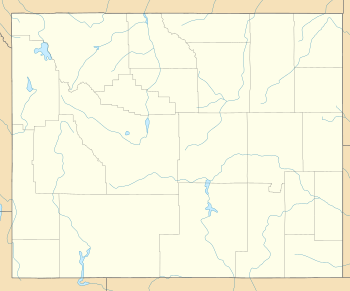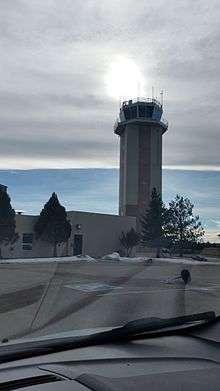Cheyenne Regional Airport
Coordinates: 41°09′20″N 104°48′38″W / 41.15556°N 104.81056°W
| Cheyenne Regional Airport Jerry Olson Field | |||||||||||||||
|---|---|---|---|---|---|---|---|---|---|---|---|---|---|---|---|
|
| |||||||||||||||
| Summary | |||||||||||||||
| Airport type | Public/Military | ||||||||||||||
| Owner | Cheyenne Regional Airport Board | ||||||||||||||
| Serves | Cheyenne, Wyoming | ||||||||||||||
| Elevation AMSL | 6,160 ft / 1,878 m | ||||||||||||||
| Website | www.CheyenneAirport.com | ||||||||||||||
| Map | |||||||||||||||
 CYS Location of airport in Wyoming / United States  CYS CYS (the US) | |||||||||||||||
| Runways | |||||||||||||||
| |||||||||||||||
| Statistics (2015) | |||||||||||||||
| |||||||||||||||

Cheyenne Regional Airport (IATA: CYS, ICAO: KCYS, FAA LID: CYS) (Jerry Olson Field) is a civil-military airport a mile north of downtown Cheyenne, in Laramie County, Wyoming. It is owned by the Cheyenne Regional Airport Board.[2]
Cheyenne Regional Airport is the home of Cheyenne Air National Guard Base, the main operating base for the Wyoming Air National Guard (WyANG) and the Wyoming Army National Guard (WARNG).
History
The U.S. Post Office gave Cheyenne's aviation its first boost. With the introduction of airmail routes after World War I, the Cheyenne civic leaders lobbied to establish Cheyenne as a stop. Buck Heffron piloted the first air mail flight destined for Salt Lake City on September 9, 1920. Heffron flew a DH-4 that could barely get high enough to clear the mountains and had a maximum speed of 100 mph (160 km/h). The pilot was one of the brave aviators who was guided by a few instruments, maps and landmarks.
Cheyenne's airport saw its first paying passengers in the 1920s. The first was Elizabeth Brown, a female barber. She enjoyed a ride with World War I pilot, C.A. McKenzie, in a Curtis Oriole biplane. With the step up to the DC-3 in 1937 passengers enjoyed greater comfort and safety. Soon United DC-3s were flying Cheyenne passengers to both coasts and south to Denver.
The Boeing/United Airlines Terminal Building, Hangar and Fountain, built for what would become United Airlines between 1929 and 1934, are listed on the National Register of Historic Places.
During World War II the airport was a completion and modification center for B-17s. Captain Ralph S. Johnson was a test pilot for the then United States Army Air Corps, forerunner to the United States Air Force. The tail turret on the B-17 is known as the "Cheyenne" turret because it was invented at Cheyenne. United Airlines maintained its Douglas DC-3s at Cheyenne; in 1946 it had 1400 employees based locally.[3] Until 1961 the airport was the training center for United Airlines stewardesses from across the country.
The airport was visited by Charles Lindbergh, aboard the "Spirit of St. Louis," and Amelia Earhart. Many historic events are chronicled on the walls of the airport restaurant. One of the airport's celebrated visitors in recent times is child aviator Jessica Dubroff, who lost her life when her small plane crashed after takeoff in terrible weather in April, 1996.
Because of its high altitude, aircraft manufacturers test their new jetliners at Cheyenne. The latest tests involved Embraer of Brazil's E-170 and E-190 aircraft as well as Boeing's 737-900 and 787 Dreamliner jets and most recently, the Boeing 737 Max 8.
The airport terminal contains plaques of the inductees into the Wyoming Aviation Hall of Fame. The 2013 inductee is Raymond A. Johnson, who lived primarily in Cheyenne after 1960.[4]
Facilities
The field covers 1,060 acres (430 ha) and has two runways: 9/27, 9,270 x 150 ft (2,825 x 46 m) concrete and 13/31, 6,690 x 150 ft (2,039 x 46 m) asphalt.[2]
The new terminal will have 3 gates and room for 1 more in the future if needed.
For the period ending September 30, 2015 the airport had 46,436 aircraft operations, average 127 per day: 44% general aviation, 49% military, 6% air taxi and <1% airline. 99 aircraft are based at this airport: 35% single-engine, 38% multi-engine, 4% jet and 22% military.[2]
Airlines and destinations
Great Lakes Airlines (operating independently and also as a codeshare partner for United Airlines) flew 19-passenger Beechcraft 1900D commuter turboprops to Cheyenne until March 26, 2018.
American Eagle,[5] flying on behalf of American Airlines, initiated nonstop Embraer ERJ-145 regional jet service to Dallas/Fort Worth, Texas (DFW) on July 15, 2010 but then ended these flights on April 3, 2012.[6]
Occasional charter flights (known as "casino or gamblers' flights") go to Laughlin or Wendover, Nevada.
Frontier Airlines and United Airlines use Cheyenne as a diversion airport on occasion for their respective services to Denver International Airport (DEN).
On August 4, 2018, American Airlines announced non-stop service to Dallas/Fort Worth International Airport (DFW), beginning November 4, 2018. These flights will be operating under the SkyWest Airlines brand.[7]
| Airlines | Destinations |
|---|---|
| American Eagle | Dallas/Fort Worth (begins November 4, 2018)[8] |
Historical airline service: 1950s through the 1990s
United Airlines served Cheyenne until 1960. In 1954, United was operating direct, no change of plane Convair 340 "Mainliner" prop aircraft service from the airport to Chicago, Detroit, Philadelphia and New York City with a daily eastbound routing of Denver - Cheyenne - Scottsbluff, NE - North Platte, NE - Grand Island, NE - Lincoln, NE - Omaha - Chicago - Detroit - Philadelphia - New York Newark Airport.[9] By 1959, United was only operating one roundtrip Convair 340 flight a day between Cheyenne and Denver.[10]
Western Airlines mainline Boeing 737-200 jet service ended in 1979-80 with the airline previously operating Lockheed L-188 Electra turboprops into the airport during the 1960s and Douglas DC-3 and Douglas DC-6B propliners into Cheyenne during the 1950s.[11] In 1966, Western was operating direct, no change of plane Electra propjet service from southern California to the airport with a daily routing of Los Angeles - San Diego - Phoenix - Denver - Cheyenne - Casper - Sheridan, WY - Billings and was also operating direct Electra service to Calgary in western Canada with a daily routing of Denver - Cheyenne - Casper - Sheridan, WY - Billings - Great Falls - Calgary.[12] By the early 1970s, Western was operating all flights into Cheyenne with Boeing 737-200 jets and in 1973 was operating two flights a day from the airport, one to Denver nonstop and the other to Billings via intermediate stops in Casper and Sheridan,WY.[13]
The original Frontier Airlines (1950-1986) also served Cheyenne with Boeing 737-200 jets as well as with turboprop aircraft such as the Convair 580 and de Havilland Canada DHC-6 Twin Otter. By 1967, Frontier was operating direct, no change of plane Convair 580 service between the airport and Dallas, Oklahoma City, Tulsa, Little Rock, Salt Lake City, Colorado Springs and other destinations in addition to nonstop flights to Denver.[14] The airline had previously served Cheyenne with Convair 340 and Douglas DC-3 prop aircraft.[15] By 1977, Frontier was operating Boeing 737-200 jets in addition to turboprop aircraft on its flights into Cheyenne.[16] In 1983, the airline was operating all of its Cheyenne flights with the Boeing 737-200 but was no longer serving the airport by the spring of 1985.[17]
Smaller regional and commuter airlines also previously served Cheyenne with service primarily to Denver including Rocky Mountain Airways with de Havilland Canada DHC-6 Twin Otter and DHC-7 Dash 7 turboprops. In 1985, Rocky Mountain Airways was the only airline operating service between Cheyenne and Denver with up to nine round trip flights a day all operated with Twin Otter aircraft.[18] By 1989, Rocky Mountain had become a Continental Express air carrier and was operating up to eight Beechcraft 1900C turboprop flights a day round trip between the airport and Denver where Continental Airlines had a connecting hub at the time.[19] In 1991, Mesa Airlines operating as United Express had joined Continental Express at the airport with these air carriers operating a combined total of up to thirteen departures a day to Denver with both airlines flying Beechcraft 1900C propjets on the route.[20] By 1995, Mesa operating as United Express with Beechcraft 1900Cs was the only airline operating service between Cheyenne and Denver.[21] In 1999, Great Lakes Airlines had replaced Mesa as the United Express air carrier serving Cheyenne and was the only air carrier operating flights from the airport with Beechcraft 1900C service to the United Airlines hub in Denver.[22]
| Carrier | Passengers (arriving and departing) |
|---|---|
| Great Lakes Airlines | 3,030(100%) |
| Rank | Airport | Passengers | Carrier |
|---|---|---|---|
| 1 | Denver, CO | 2,000 | Great Lakes |
Cargo
| Airlines | Destinations |
|---|---|
| Key Lime Air | Denver-Centennial, Denver, Denver-Rocky Mountain, Grand Junction |
Cheyenne Air National Guard Base
Cheyenne ANGB occupies approximately 77 acres of leased land on the Cheyenne Regional Airport. The host wing is the 153d Airlift Wing (153 AW) of the Wyoming Air National Guard, flying the C-130 Hercules theater airlift aircraft. The 153 AW is operationally-gained by the Air Mobility Command (AMC), and given its proximity to F. E. Warren AFB, was chosen as the first "Active-Associate" unit in the U.S. Air Force and the Air National Guard. As an Active-Associate unit, the 153 AW incorporates both a traditional Air National Guard C-130 airlift squadron, the 187th Airlift Squadron (187 AS), and a full-time active duty Regular Air Force C-130 airlift squadron, the 30th Airlift Squadron (30 AS). Both squadrons share the same C-130H aircraft.[24]
Cheyenne ANGB also hosts an Army Aviation Support Facility (AASF) of the Wyoming Army National Guard, operating UH-60 Blackhawk helicopters.
Incidents and Accidents
On April 11, 1996, 7 year old Jessica Dubroff, along with her father and flight instructor, died when her general aviation aircraft crashed after takeoff from Cheyenne Regional in a storm. Dubroff was attempting to be the youngest person to fly across the United States.
See also
References
- ↑ Cheyenne Regional Airport, official web site
- 1 2 3 4 FAA Airport Master Record for CYS (Form 5010 PDF), effective 2007-12-20
- ↑ American Aviation 15 Oct 1946 p34
- ↑ "James Chilton, Hall of Fame inductee grew alongside aviation industry, September 26, 2013". Wyoming Tribune-Eagle. Retrieved September 27, 2013.
- ↑ "Fly Cheyenne to Dallas". Wyoming Tribune Eagle. 2010-03-23. Retrieved 2010-04-03.
- ↑ http://www.coloradoan.com/article/20120208/UPDATES03/120208013/1046/rss03
- ↑ https://www.apnews.com/eb066c10d44249878d0d47bf935f7cdc
- ↑ https://www.usatoday.com/story/travel/flights/todayinthesky/2018/08/09/american-airlines-wyoming-flights-cheyenne/946769002/
- ↑ http://www.timetableimages.com, Aug. 1, 1954 United Air Lines system timetable
- ↑ http://www.timetableimages.com, April 1, 1959 United Air Lines system timetable
- ↑ http://www.timetableimages.com, June 10, 1958 Western Airlines system timetable
- ↑ http://www.timetableimages.com, Aug. 1, 1966 Western Air Lines system timetable
- ↑ http://www.departedflights.com, June 6, 1973 Western Airlines system timetable
- ↑ http://www.timetableimages.com, Oct. 29, 1967 Frontier Airlines system timetable
- ↑ http://www.timetableimages.com, Aug. 1, 1964 Frontier Airlines system timetable
- ↑ http://www.departedflights.com, June 6, 1977 Frontier Airlines system timetable
- ↑ http://www.departedflights.com, June 1, 1983 & April 4, 1985 Frontier Airlines route maps
- ↑ http://www.departedflights.com, Feb. 15, 1985 Official Airline Guide (OAG), Denver-Cheyenne flight schedules
- ↑ http://www.departedflights.com, Dec. 15, 1989 Official Airline Guide (OAG), Denver-Cheyenne flight schedules
- ↑ http://www.departedflights.com, Oct. 1, 1991 Official Airline Guide (OAG), Denver-Cheyenne flight schedules
- ↑ http://www.departedflights.com, April 2, 1995 Official Airline Guide (OAG), Denver-Cheyenne flight schedules
- ↑ http://www.departedflights.com, June 1, 1999 Official Airline Guide (OAG), Denver-Cheyenne flight schedules
- 1 2 "Cheyenne, WY: Cheyenne Regional (CYS)". Bureau of Transportation Statistics (BTS), Research and Innovative Technology Administration (RITA), U.S. Department of Transportation. February 2016. Retrieved February 17, 2017.
- ↑ http://www.153aw.ang.af.mil/units/index.asp
External links
- Airport website
- FAA Airport Diagram (PDF), effective October 11, 2018
- Resources for this airport:
- AirNav airport information for KCYS
- ASN accident history for CYS
- FlightAware airport information and live flight tracker
- NOAA/NWS latest weather observations
- SkyVector aeronautical chart for KCYS
- FAA current CYS delay information
- Cheyenne Airfield, 200 East Eighth Avenue, Cheyenne, Laramie, WY at the Historic American Engineering Record (HAER)
- Wyoming Air National Guard Base, Cheyenne Airport, Cheyenne, Laramie, WY at HAER, also , , , at HAER